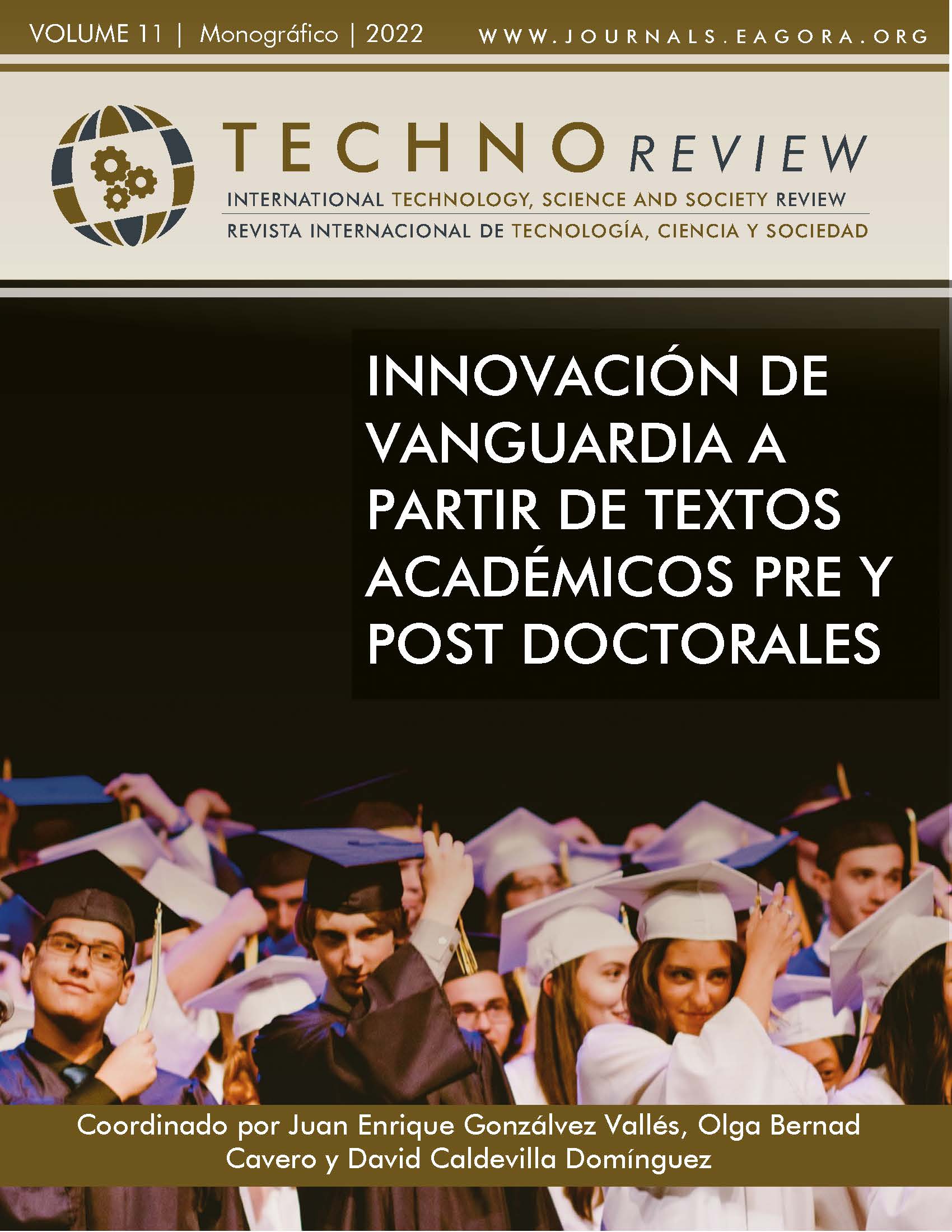El modelo de innovación Triple Hélice
Un análisis de la producción científica
DOI:
https://doi.org/10.37467/revtechno.v11.4453Palabras clave:
Triple Hélice, Innovación, Economía del conocimiento, Política científica, BibliometríaResumen
En este trabajo se analiza la producción científica sobre el modelo de la Triple Hélice, basado en la interacción entre universidad-industria-gobierno, el cual resalta la relevancia del rol de las universidades en la transición de una sociedad industrial hacia otra basada en el conocimiento. Se utilizaron indicadores bibliométricos y técnicas de análisis factorial. Se recuperaron un total de 593 publicaciones indexadas en la colección central de Web of Science (WoS), desde 1993 hasta 2022. Se identificaron los autores, países, instituciones y revistas más productivas, los manuscritos con mayor impacto y la estructura temática y conceptual en el campo científico analizado.
Citas
Amable, B., Barré, R., & Boyer, R. (2008). Los sistemas de innovación en la era de la globalización. Ciepp - Miño y Dávila.
Aria M., Cuccurullo C. (2017). Bibliometrix: An R-tool for comprehensive science mapping analysis. Journal of Informetrics, 11(4),959-75. https://doi.org/10.1016/j.joi.2017.08.007
Bradford, S. C. (1985). Sources of information on specific subjects 1934. Journal of Information Science, 10(4), 176-80.
Carayannis, E. G. & Campbell, D. F. J. (2009). ‘Mode 3’ and ‘Quadruple Helix’: toward a 21st century fractal innovation ecosystem. International Journal of Technology Management, 46(3-4), 201-34. https://doi.org/10.1504/IJTM.2009.023374
Carayannis, E. G. & Campbell, D. F. J. (2010). Triple Helix, Quadruple Helix and Quintuple Helix and how do knowledge, innovation and the environment relate to each other? A proposed framework for a trans-disciplinary analysis of sustainable development and social ecology. International Journal of Social Ecology and Sustainable Development, 1(1), 41-69. https://www.igi-global.com/article/triple-helix-quadruple-helix-quintuple/41959
Carayannis, E. G. & Rakhmatullin, R. (2014). The Quadruple/Quintuple Innovation Helixes and Smart Specialisation Strategies for Sustainable and Inclusive Growth in Europe and Beyond. Journal of the Knowledge Economy, 5, 212-39. https://doi.org/10.1007/s13132-014-0185-8
Etzkowitz, H. & Leydesdorff, L. (1995). The Triple Helix—university–industry–government relations: a laboratory for knowledge based economic development. EASST Review, 14, 14-19.
Etzkowitz, H. & Leydesdorff, L. (1997). Universities and the Global Knowledge Economy: A Triple Helix of University-Industry-Government Relations. Pinter.
Etzkowitz, H. & Leydesdorff, L. (1998). The endless transition: A “Triple Helix” of university–industry–government relations, Introduction to a theme issue. Minerva, 36, 203-08.
Etzkowitz, H. (2003). Innovation in Innovation: The Triple Helix of University-Industry-Government Relations. Social Science Information, 42(3), 293-337. https://doi:10.1177/05390184030423002
Etzkowitz, H., & Leydesdorff, L. (2000). The dynamics of innovation: from National Systems and “Mode 2” to a Triple Helix of university–industry–government relations. Research Policy, 29(2), 109-23. https://doi.org/10.1016/S0048-7333(99)00055-4
Etzkowitz, H., de Mello, J. M. C. & Almeida, M. (2005). Towards “meta-innovation” in Brazil: The evolution of the incubator and the emergence of a triple hélix. Research Policy, 34(4), 411-24. https://doi.org/10.1016/j.respol.2005.01.011.
Etzkowitz, H., Webster, A., Gebhardt, C., Terra, B. R. C. (2000). The future of the university and the university of the future: evolution of ivory tower to entrepreneurial paradigm. Research Policy, 29(2), 313-30. https://doi.org/10.1016/S0048-7333(99)00069-4
Fernández, S. F. (2011). Análisis Factorial. https://docplayer.es/9019720-Santiago-de-la-fuente-fernandez-analisis-factorial.html
Hartigan, J. A., Wong, M. A. (1979). A K-means Clustering Algorithm. Journal of the Royal Statistical Society. Series C (Applied Statistics), 28(1), 100-8. https://doi.org/10.2307/2346830
Hirsch, J. E . (2005). An index to quantify an individual’s scientific research output. Proceedings of the National Academy of Sciences (PNAS) USA, 102(46), 16569-72. https://doi.org/ 10.1073/pnas.0507655102.
Leydesdorff, L. & Meyer, M. (2006). Triple Helix indicators of knowledge-based innovation systems: Introduction to the special issue. Research Policy, 35(10). https://doi.org/10.1016/j.respol.2006.09.016.
Leydesdorff, L. (2000). The triple helix: an evolutionary model of innovations. Research Policy, 29(2). https://doi.org/10.1016/S0048-7333(99)00063-3
Leydesdorff, L. (2012). The Triple Helix, Quadruple Helix, …, and an N-Tuple of Helices: Explanatory Models for Analyzing the Knowledge-Based Economy?. Journal of the Knowledge Economy, 3, 25-35. https://doi.org/10.1007/s13132-011-0049-4
Ranga, M. & Etzkowitz, H. (2013). Triple Helix Systems: An Analytical Framework for Innovation Policy and Practice in the Knowledge Society. Industry and Higher Education, 27(4), 237-62. https://doi.org/10.5367/ihe.2013.0165
Sábato, J. A. & Botana, N. (1968). La ciencia y la tecnología en el desarrollo futuro de América Latina. Revista de la integración, 1(3), 15-36.
Sábato, J. A. (1975). El pensamiento latinoamericano en la problemática ciencia-tecnología-desarrollo-dependencia. Paidós.
Sábato, J. A. & Mackenzie, M. (1982). La producción de tecnología. Autónoma o transnacional. Nueva Imagen.
Singer, P. (2009) Relaciones entre sociedad y estado en la economía solidaria. Íconos, 33, 51-65.
Van Raan AFJ. (2005). Measurement of Central Aspects of Scientific Research: Performance, Interdisciplinarity. Measurement, 3, 1-19. https://doi.org/10.1207/s15366359mea0301_1
Zhang, J., Yu, Q., Zheng, F., Long, Ch., Lu, Z., Duan, Z. (2016). Comparing keywords plus of WOS and autor keywords: a case study of patient adherence research. Journal of the Association for Information Science and Technology, 67, 967-72. https://doi.org/10.1002/asi.23437
Descargas
Publicado
Cómo citar
Número
Sección
Licencia
Aquellos autores/as que publiquen en esta revista, aceptan los términos siguientes:
- Los autores/as conservarán los derechos morales sobre la obra y cederán a la revista los derechos comerciales.
- Transcurrido un año desde su publicación, la versión del editor pasará a estar en acceso abierto en la web de la editorial, pero la revista mantendrá el copyright de la obra.
- En el caso de que los autores deseen asignar una licencia abierta Creative Commons (CC), podrán solicitarla escribiendo a publishing@eagora.org







